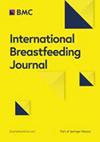患有先天性心脏病的初产妇的母乳喂养--一项登记研究
IF 2.9
2区 医学
Q1 OBSTETRICS & GYNECOLOGY
引用次数: 0
摘要
患有先天性心脏病(CHD)的孕妇人数正在上升,这种疾病增加了孕期心血管和产科并发症的风险,可能会影响母乳喂养的成功率。本研究旨在调查患有先天性心脏病的初产妇与未患有先天性心脏病的初产妇的母乳喂养情况,并研究患有先天性心脏病的初产妇母乳喂养的潜在阻碍因素。数据收集于2014年至2019年,通过合并瑞典先天性心脏病登记册(SWEDCON)和瑞典妊娠登记册获得。年龄≥18岁的患有先天性心脏病的初产妇(n = 578)与3049名在22孕周后分娩的无先天性心脏病妇女按年龄和市镇进行了配对。通过多变量逻辑回归分析,确定了患有先天性心脏病的妇女不进行母乳喂养的相关因素。患有先天性心脏病的妇女在产后两天(94% 对 97%,p = 0.001)和四周(84% 对 89%,p = 0.006)进行母乳喂养的人数少于未患有先天性心脏病的妇女。对所有妇女进行分析后发现,患有先天性心脏病的妇女在产后两天和四周内均未进行母乳喂养。对于患有先天性心脏病的妇女,体重指数 (BMI) ≥ 30 (OR 3.1; 95% CI 1.4, 7.3)、早产 (OR 6.4; 95% CI 2.1, 19.0)、自述精神病史 (OR 2.4; 95% CI 1.2, 5.1)、胎龄偏小 (OR 2.4; 95% CI 1.2, 5.1)、早产 (OR 6.4; 95% CI 2.1, 19.0)1)、胎龄小(OR 4.2;95% CI 1.4,12.2)和纽约心脏协会心力衰竭分期 II - III 级(OR 6.0;95% CI 1.4,26.7)与出生两天后未母乳喂养有关。出生四周后,与不母乳喂养相关的因素有体重指数≥30(OR 4.3;95% CI 2.1,9.0)、自述精神病史(OR 2.2;95% CI 1.2,4.2)和早产(OR 8.9;95% CI 2.8,27.9)。研究表明,大多数患有心脏病的妇女都会进行母乳喂养,但与无心脏病的妇女相比,母乳喂养的比例略低。此外,与心脏病有关的因素与婴儿出生四周后未进行母乳喂养无关。由于早产、体重指数(BMI)≥ 30 和精神疾病与不母乳喂养有关,医护人员应为患有这些疾病的心脏病妇女提供更多支持。本文章由计算机程序翻译,如有差异,请以英文原文为准。
Breastfeeding in primiparous women with congenital heart disease − a register study
The number of pregnant women with congenital heart disease (CHD) is rising, and the disease poses increased risks of cardiovascular and obstetric complications during pregnancy, potentially impacting breastfeeding success. This study aimed to investigate breastfeeding in primiparous women with CHD compared to primiparous women without CHD, and to examine potential hindering factors for breastfeeding in women with CHD. The data were gathered between 2014 and 2019 and obtained by merging the Swedish Congenital Heart Disease Register (SWEDCON) with the Swedish Pregnancy Register. Primiparous women ≥ 18 years of age with CHD (n = 578) were matched by age and municipality to 3049 women without CHD, giving birth after 22 gestational weeks. Multivariable logistic regression analysis was used to identify factors associated with non-breastfeeding in women with CHD. Fewer women with CHD breastfed than women without CHD two days (94% vs. 97%, p = 0.001) and four weeks after birth (84% vs. 89%, p = 0.006). When all women were analysed, having CHD was associated with non-breastfeeding at both two days and four weeks after birth. For women with CHD, body mass index (BMI) ≥ 30 (OR 3.1; 95% CI 1.4, 7.3), preterm birth (OR 6.4; 95% CI 2.1, 19.0), self-reported history of psychiatric illness (OR 2.4; 95% CI 1.2, 5.1), small for gestational age (OR 4.2; 95% CI 1.4, 12.2), and New York Heart Association Stages of Heart Failure class II − III (OR 6.0; 95% CI 1.4, 26.7) were associated with non-breastfeeding two days after birth. Four weeks after birth, factors associated with non-breastfeeding were BMI ≥ 30 (OR 4.3; 95% CI 2.1, 9.0), self-reported history of psychiatric illness (OR 2.2; 95% CI 1.2, 4.2), and preterm birth (OR 8.9; 95% CI 2.8, 27.9). The study shows that most women with CHD breastfeed, however, at a slightly lower proportion compared to women without CHD. In addition, factors related to the heart disease were not associated with non-breastfeeding four weeks after birth. Since preterm birth, BMI ≥ 30, and psychiatric illness are associated with non-breastfeeding, healthcare professionals should provide greater support to women with CHD having these conditions.
求助全文
通过发布文献求助,成功后即可免费获取论文全文。
去求助
来源期刊

International Breastfeeding Journal
Medicine-Obstetrics and Gynecology
CiteScore
6.30
自引率
11.40%
发文量
76
审稿时长
32 weeks
期刊介绍:
Breastfeeding is recognized as an important public health issue with enormous social and economic implications. Infants who do not receive breast milk are likely to experience poorer health outcomes than breastfed infants; mothers who do not breastfeed increase their own health risks.
Publications on the topic of breastfeeding are wide ranging. Articles about breastfeeding are currently published journals focused on nursing, midwifery, paediatric, obstetric, family medicine, public health, immunology, physiology, sociology and many other topics. In addition, electronic publishing allows fast publication time for authors and Open Access ensures the journal is easily accessible to readers.
 求助内容:
求助内容: 应助结果提醒方式:
应助结果提醒方式:


